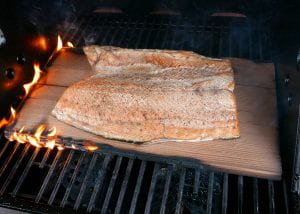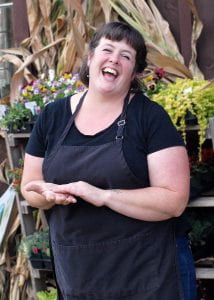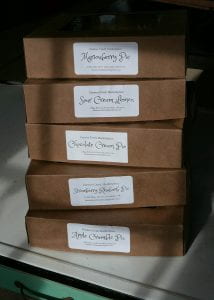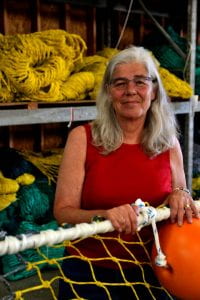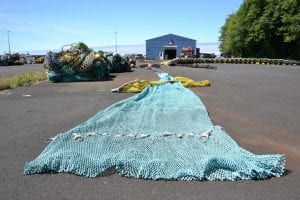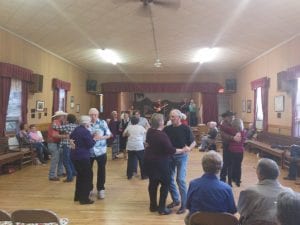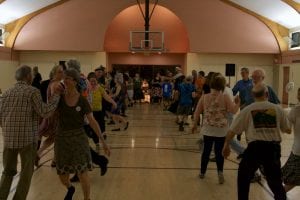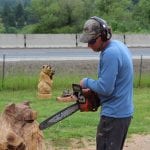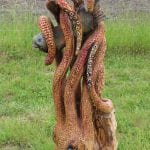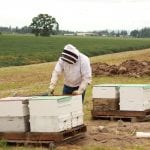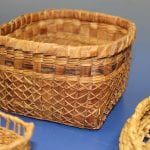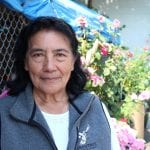Douglas Manger
Like a twisting myrtlewood tree growing close by the sea, Highway 101 makes its way in circuitous fashion along Oregon’s spectacular Pacific coastline. During the month of August, Joe O’Connell and I trekked this evocative route, flush with names that spark imaginings of what folkways might be found in places like Winchester Bay, Dunes City, Yachats, Seal Rock, Neskowin, Manzanita, Astoria.
Persist and you will find tradition keepers at every turn. Clatsop County’s Andy Carlson is one of them. Bent slightly with age, Carlson can often be found out back tending salmon sides in his home-built smokehouse. Like many in and around Astoria, his ancestry is part Finnish, part Swedish. Look at Carson’s hands, they speak volumes of a life shaped by tradition on the Columbia River. He was a tug boater for 12 years and a pilot boat owner/operator for 32 years. Watch his hands. Carlson skillfully fillets, cures, then hot or cold smokes sides of salmon that many locals call the best around. That spelled eight years of trial and error with regular visits to his mentor (now passed)—a master at smoking salmon—before the acknowledgment came, “I think you’ve got it.”
How do we find such special tradition keepers? Serendipity plays a role. Scout the main mercantile street in Astoria, introduce yourself to Saara Matthews at Finn Ware, explain the project, and voila: “My father, Andy Carlson, is someone you might find interesting.”
Like that wind-twisted myrtlewood tree, generational traditions don’t always come down in a straight line. For Sandra Porter it was her grandmother who instilled in her a love of cooking and making do. At the Porter’s farmstand near Cloverton, at what was once her grandparent’s farm, you’ll get a feel for her grandmother’s influence: fresh cut flowers for sale, along with produce from their garden; fresh fish from Waylon Porter’s morning dory run; bulbs from the countless varieties her grandparents planted across the road in the 1990s; ice cream, and, oh, yes, Sandra Porter’s famous pies! Be it winter or summer, once the word is out on Facebook, her pies—marionberry, strawberry, apple crumble pie, to name a few—literally fly off the shelf.
A favorite is pumpkin pie made with green, home-grown, Jarrahdale pumpkins that top 50 pounds. Once cut into large wedges Porter roasts them in the oven to give the pie “another elevation of flavor.”
To make food, to cook for people, is just a really great way to show people that you love them, and you care about them. And people, people need that right now. Everybody needs nourished and they need more love.”
Why the popularity of Carlson’s smoked salmon or Porter’s homemade pies? In each instance, under the watchful eye of an elder, they had a starting point from which to learn and to grow—and by introducing their own preferences—to make the making their own.
Given their heartfelt connections to the past, within this context their methodologies spark a duality, providing nourishment on the one hand and emotional sustenance on the other. It then becomes not just a smoked salmon or a homemade pie—it becomes “Andy Carson’s special smoked salmon” and “Sandra Porter’s special homemade pies” in all their resonance with a nod from generations past.
Douglas Manger is a career folklorist with over 20 years of experience. Since 2014 he has collaborated with OFN on folklife surveys in Southeastern Oregon (Malheur and Harney counties); the High Desert region, 2016 (Deschutes, Crook, Baker, Union); Portland Metro region, 2016 (Yamhill and Clackamas); and in August of this year, the Oregon coast (Douglas, Tillamook, Clatsop). Early in his career, Manger directed the Northern Tier Cultural Alliance in Pennsylvania. He later managed folk and traditional arts programming at Mid Atlantic Arts Foundation in Baltimore serving nine states and jurisdictions. At Mid Atlantic, Manger project managed the award-winning publication, From Bridge to Boardwalk: An Audio Journey Across Maryland’s Eastern Shore. In 2007, Manger returned home to Texas to found HeritageWorks. HeritageWorks has since conducted multi-year regional folklife field surveys in South and East Texas for the Institute of Texan Cultures in San Antonio, and in Baton Rouge and vicinity for the Louisiana Folklife Program.

